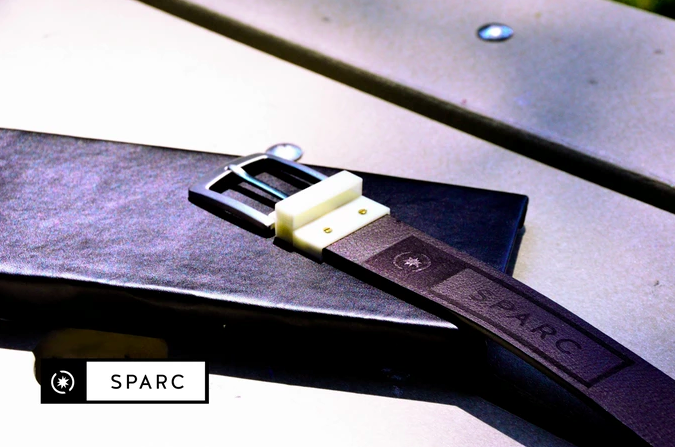Entrepreneurial Profile: Sparc Belts’ team will launch product campaign soon
Sparc Belts is working on two buckles that will come in two colors of straps.
October 3, 2015
Jefferson students sophomore Justin Zhou and junior Jami Park, along with innovators from the San Francisco Bay Area and Abu Dhabi, combined their skill sets into a mixing pot, concocting a new menswear solution known as Sparc Belts.
Beginning at an entrepreneurial summer program, Leangap, the team of six took advantage of their limited resources to create two sets of modular belts that can conveniently be matched for daily use.
Currently, the team is meeting with manufacturers to produce the belts, and will be racking up support for their campaign on Kickstarter in mid-October. To learn more about the product, visit the site here.
Q-and-A: On Oct. 3, tjTODAY interviewed Zhou to learn more about the process of creating Sparc Belts and their upcoming plans.
Q: How did you come up with the name of “Sparc Belts” for your product?
A: There’s a long term mission behind the company, that if we gain enough traction and capital in the near future, we plan on doing collaborations with worthy causes on certain straps and buckles that would donate a portion of the proceeds. The word “sparc” is meant to help people see their “inner light”.
Q: What are your team’s goals for the belt?
A: In the short term we’d like to meet or surpass our kickstarter goal. In the long term, it would be great if everyone could have modular style belt buckles and straps in their closets. I mean, people love to mix and match parts of their outfits right? Why not take that down to a smaller level?
Q: What was your process of designing and building Sparc Belts’ prototype?
A: We modeled it with computer-aided design (CAD). We’ve made almost a dozen versions since the very first one, using the Boston University Engineering Product Innovation Center (EPIC) lab and some Massachusetts Institute of Technology makerspaces to print them. We bought cheaper belts and magnets in bulk online, and now we’re working with manufacturers to make molds for the parts.
Q: So far, how much time have you dedicated to working on your project?
A: That’s hard to answer. Over the summer it was hundreds of hours, and a 6 week program that was overnight. Since school has started, including meetings, about two dozen hours.
Q: What did you like most about your summer experience creating Sparc Belts at Leangap?
A: It really expanded my view about both the startup world and the world in general. There are a lot of things glamorized by the media about startups that cover up the struggles underneath. I’ve personally seen a lot of people trying to screw over their friends and try to take over the company. If things get emotional people threaten to sue each other over use of intellectual property. You at least have nights where you don’t sleep. Trust me, Leangap could have been a TV drama at some points.
Q: Have you fallen to these struggles as well?
A: Yeah, some of them. The biggest thing Sparc had to go through was that there was a 7th member who originally proposed and patented the belt idea: he was 20 years old, looking to be a professional hockey player, but he kept talking about kicking members off the team because he thought that he was the most important member. What he didn’t understand was that in the startup community ideas don’t matter nearly as much as the execution. After the program ended, he sent an email to all of us basically proclaiming that he was the most important member and that it was our choice whether we wanted to continue working with him. The rest of the team came together and decided that [the member’s] biggest contributions were that he thought of the idea and that he narrated the first 20 seconds of [Sparc Belt’s] video. So, we decided to redesign the part so it wouldn’t be subject to his patent and we kicked him off of [the team].
Q: What is your role in the team’s organization?
A: I was the main prototyper during the program. I made all of the 3D designs and built most of the prototypes with [a team member’s] help. I feel like the lines blur a lot though in a startup of our stage because everybody does a little bit of everything.
Q: What was your favorite part of the project?
I’d say my favorite part is taking the idea of Sparc and bringing it to life. There was a time when we didn’t have prototypes, a logo, a website, a Kickstarter campaign, or anything. Just seeing the progress we’ve made inspires me to keep working.
Q: If you had the choice, would you prefer to continue working on this project or start a new one that you come up with?
A: I think we’re so deep in that I’d like to ride Sparc Belts through until after the Kickstarter campaign at least, or potentially years into the future if it gets successful enough. If Sparc Belts doesn’t reach it’s goal, which I would say is fairly unlikely, I would be interested in pursuing new ideas. But like I said, I’m confident we can get to our Kickstarter goal.
Q: What would you like to be when you grow up?
A: Honestly I’m still not sure yet. Part of the reason I applied to Leangap was to really discover myself, but all it did was open up a new world of options of things I could do in the future.






